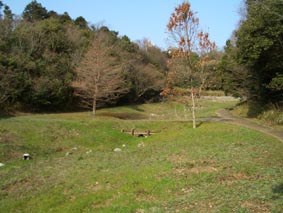
BUGS CLUB
Let's find hiding insects in a winter field! (For Adults. Used for Nature Interpretation Seminar)

Found you!
Objectives:
1.Understand characteristics of a specific field by searching insects in the place.
2.Understand their habitat segregations by time and strategies to pass the winter by observing them.
3.Think about impacts of environmental changes to insects. Think about relationships with human beings. Those will trigger behaviors to preserve nature around you.
Focus on the experiences. Then, people can start their own program development by themselves after they go back home.
Procedure: (An example of the activity held in NACS-J Nature Interpretation Seminar at Awaji Lnadscape Planning & Horticulture Academy)
1. What is an insect? Definitions from a dictionary. Half of living species are insects. Position of insects on the animal genealogical tree. Distributions of insects. Then, charcteristics of Awaji island?
- There are giant water bugs graded as Endangered Species A in Awaji island though it is graded as B in the other areas of Hyogo prefecture.
- The island was isolated from the main Japan island at around 4 to 1 million years ago.
- There have been development projects of hill areas, and pesticides have been used for agricultures.
Based on the above, Awaji island is an isolated space. Thus, once disturbed, it could be difficult to return it back to the original environment. Most of the insects in Awaji island have been isolated from Rokko mountains for 1-4 million years, and some of the species can be endangered easily. With those understandings, let's go out finding insects today.
2. What is Nature Watching of Insects? Are we going to do it in winter? No insects will be there??! (Please try as if you are tricked!) They are hiding! Let's do a practice to find a hiding insect. (Show a picture of Coreid bug (Homoeocerus unipunctatus) hiding in grass.). You become able to see the things you were not able to see before by this practice. Once you find any, please look at it very carefully. (Think about how fun it is when you find something by making a close overvation.)
3. What did you find? Can you think about characteristics of this place? What kind of grass field is this place? How you can search?
4. What did the insect do when you found it? Can you think what does it do in the other seasons? How the environment would be in the other seasons? Then, what do the other insects do, and what the other animals...?
5. What is hybernation? Let's do an experiment! How different from the winter life of human beings?
Wish all the insects fly actively even in winter... But it is cold winter.
(Show groundhoppers in glass tubes. One at warm temperature and the other is at cold temperature.)
Insects are relatively smaller. (Pour hot water into a big bottle with a picture of a cat and a small bottle with a picture of a rhinoceros beetle. Touch the bottles after a few minutes.)
You see insects like this small bottle can easily loose their heat.
That is why honeybees warm themselves.
Then, let's do another experiment. Some insects do not freeze even below ice temperature.
Pour water in a glass tube, and in another glass tube, pour water and some glycerin that exists in body of some insects in winter. Put two tubes in an ice box.
While waiting for a few minutes, let's see how honey bees feel by getting together with some friends in a nylon sheet.
You see. The water has become ice, but the one with glycerin does not freeze.
6. Reflection. What happen if the environment is changed. Can we detect the changes easily? Is the environment change occured by progresses of plants or impacts by human-beings? Any impacts to human-beings in the end? What should we do? (What did you learnby looking for insects and by making close observatoins? Did you find anything? Think about relationships between insects and you. How would you do when you play a role of facilitator?)
7. Summary of program development and actual guides. (Encourage doing by yourself. Share references.
Materials:
| □ Leaflet | □ Summary of Program Development and Actual Guides |
| □ Guid Board | □ Salt, Ices, Ice box |
| □ Thermometer | □ Desk |
| □ Bottle with water | □ 4 Glass tube |
| □ Glycerin | □ Camping stove |
| □ Nylon sheet |
Pictures of the activity :
At Interpreter Seminar by NACS-J at Hyogo Prefectural Awaji Lnadscape Planning & Horticulture Academy on Nov 27th to Nov 29th, '09:

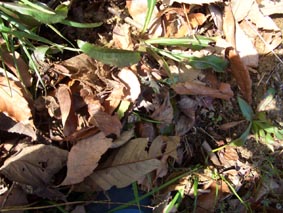
Field (The pictures were taken a year ago.)

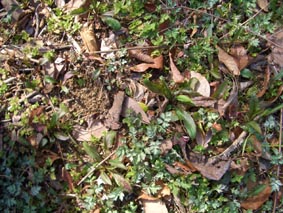
Coreid bug. Lady bug
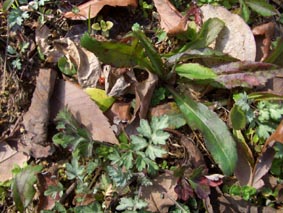

It is easier to find when it is enlarged.
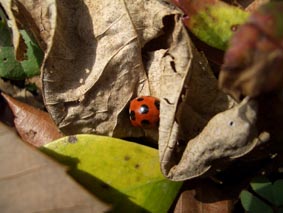
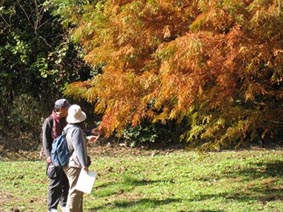

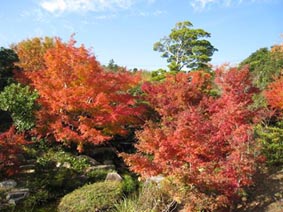
Actual interpretation by a participant in the last day. Beautiful leaves!
Copyright © 2002 - 2017 むしむしくらぶ BUGS CLUB All Rights Reserved